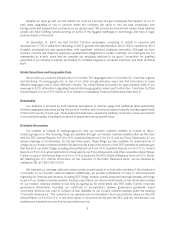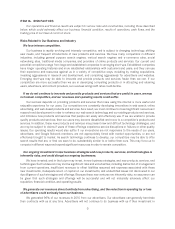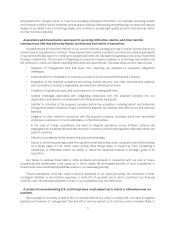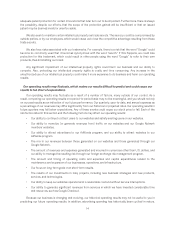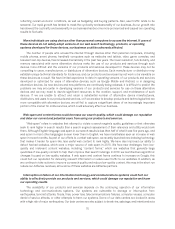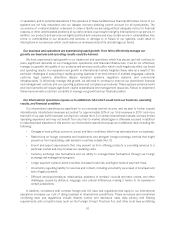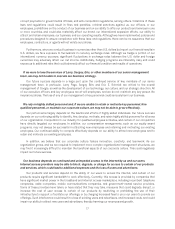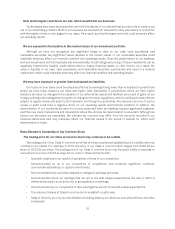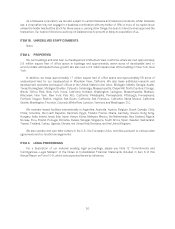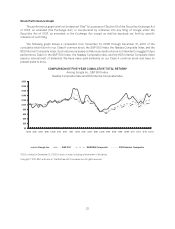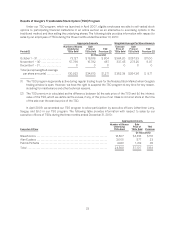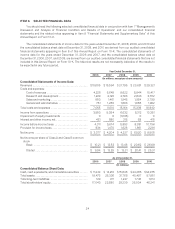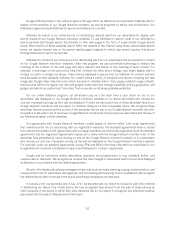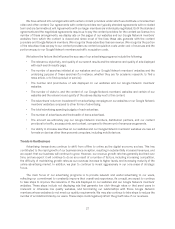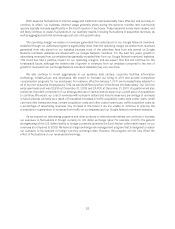Google 2010 Annual Report Download - page 31
Download and view the complete annual report
Please find page 31 of the 2010 Google annual report below. You can navigate through the pages in the report by either clicking on the pages listed below, or by using the keyword search tool below to find specific information within the annual report.New technologies could block our ads, which would harm our business.
Technologies have been developed that can block the display of our ads and that provide tools to users to opt
out of our advertising products. Most of our revenues are derived from fees paid to us by advertisers in connection
with the display of ads on web pages for our users. As a result, such technologies and tools could adversely affect
our operating results.
We are exposed to fluctuations in the market values of our investment portfolio.
Although we have not recognized any significant losses to date on our cash, cash equivalents, and
marketable securities, any significant future declines in the market values of our marketable securities could
materially adversely affect our financial condition and operating results. Given the global nature of our business,
we have investments both domestically and internationally. Credit ratings and pricing of these investments can be
negatively impacted by liquidity, credit deterioration or losses, financial results, or other factors. As a result, the
value or liquidity of our cash, cash equivalents, and marketable securities could decline and result in a material
impairment, which could materially adversely affect our financial condition and operating results.
We may have exposure to greater than anticipated tax liabilities.
Our future income taxes could be adversely affected by earnings being lower than anticipated in jurisdictions
where we have lower statutory tax rates and higher than anticipated in jurisdictions where we have higher
statutory tax rates, by changes in the valuation of our deferred tax assets and liabilities, as a result of gains on our
foreign exchange risk management program, or changes in tax laws, regulations, and accounting principles. We are
subject to regular review and audit by both domestic and foreign tax authorities. Any adverse outcome of such a
review or audit could have a negative effect on our operating results and financial condition. In addition, the
determination of our worldwide provision for income taxes and other tax liabilities requires significant judgment,
and there are many transactions and calculations where the ultimate tax determination is uncertain. Although we
believe our estimates are reasonable, the ultimate tax outcome may differ from the amounts recorded in our
financial statements and may materially affect our financial results in the period or periods for which such
determination is made.
Risks Related to Ownership of Our Common Stock
The trading price for our Class A common stock may continue to be volatile.
The trading price of our Class A common stock has at times experienced substantial price volatility and may
continue to be volatile. For example, in 2010, the price of our Class A common stock ranged from $433.63 per
share to $630.85 per share. The trading price of our Class A common stock may fluctuate widely in response to
various factors, some of which are beyond our control. These factors include:
• Quarterly variations in our results of operations or those of our competitors.
• Announcements by us or our competitors of acquisitions, new products, significant contracts,
commercial relationships, or capital commitments.
• Recommendations by securities analysts or changes in earnings estimates.
• Announcements about our earnings that are not in line with analyst expectations, the risk of which is
enhanced because it is our policy not to give guidance on earnings.
• Announcements by our competitors of their earnings that are not in line with analyst expectations.
• The volume of shares of Class A common stock available for public sale.
• Sales of stock by us or by our stockholders (including sales by our directors, executive officers, and other
employees).
18


